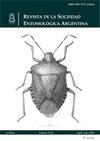Alfa and beta diversity of thrips (Thysanoptera) and biological control agents in chrysanthemum flowers (Chrysanthemum sp.) of two ecoregions in Jujuy province, Argentina
IF 0.5
4区 农林科学
Q4 ENTOMOLOGY
引用次数: 1
Abstract
The objectives of this study are to identify thrips and their biological controllers, to analyze their abundance in three flower opening stages stages of chrysanthemum crops, and to determine alpha and beta diversity in two ecoregions of Jujuy province (Argentina). The study was carried out in the Chaco ecoregion (ECH) in October and November 2016, and in the Prepuna ecoregion (EP) in February and March 2018. On each date, six replicates of five flowers were excised in the stages: flower bud , semi-open flower and open flower. Diversity profiles and rank-abundance curves were built, and Jaccard's coefficient of similarity was applied. The diversity profiles showed significant differences in thrips communities. In the ECH, 15 thrips species were identified; the dominant and permanent species were Microcephalothrips abdominalis (Crawford) and Frankliniella occidentalis (Pergande). Five species were recorded in the EP, although Frankliniella gemina Bagnall and Thrips tabaci Lindeman on their own represented 78% of the total abundance. In the ECH, 20 entomophagous species/morphospecies were recognized, and 19 in the EP; antocorids were dominant in both ecoregions. The thrips and the entomophagous communities of chrysanthemum flowers were different (34%) between the ecoregions studied.阿根廷胡胡伊省两个生态区蓟马(Thysanoptera) α和β多样性及菊花(chrysanthemum sp.)生物防治剂的研究
本研究的目的是鉴定蓟马及其生物控制因子,分析其在阿根廷胡胡伊省两个生态区菊花作物三个开花阶段的丰度,并测定α和β的多样性。该研究于2016年10月和11月在查科生态区(ECH)和2018年2月和3月在普普纳生态区(EP)进行。在每个日期,在花蕾、半开放花和开放花的阶段切除6个重复,各5个花。建立多样性曲线和等级-丰度曲线,采用Jaccard相似系数。蓟马群落多样性分布差异显著。在ECH中鉴定出15种蓟马;优势种为腹小头蓟(Crawford)和西富兰克林蓟(Frankliniella occidentalis)。尽管Frankliniella gemina Bagnall和Thrips tabaci Lindeman单独占总丰度的78%,但在EP中记录了5种。在ECH中鉴定出20个食虫种/形态种,在EP中鉴定出19个;蚁科昆虫在两个生态区均占优势。蓟马和菊花的食虫群落在不同生态区之间存在差异(34%)。
本文章由计算机程序翻译,如有差异,请以英文原文为准。
求助全文
约1分钟内获得全文
求助全文
来源期刊

Revista De La Sociedad Entomologica Argentina
Agricultural and Biological Sciences-Insect Science
CiteScore
0.80
自引率
20.00%
发文量
31
审稿时长
20 weeks
 求助内容:
求助内容: 应助结果提醒方式:
应助结果提醒方式:


